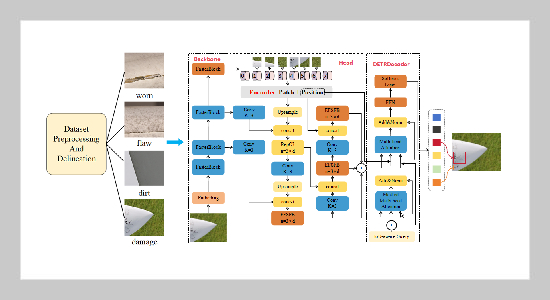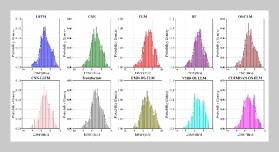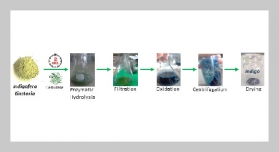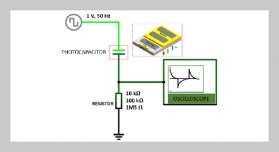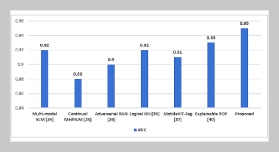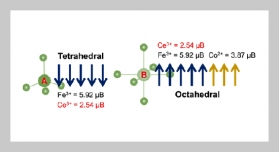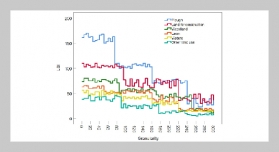- [1] F. Jaramillo, J. M. Gutiérrez, M. Orchard, M. Guar ini, and R. Astroza, (2022) “A Bayesian approach for fatigue damage diagnosis and prognosis of wind turbine blades" Mechanical Systems and Signal Processing 174: 109067. DOI: 10.1016/j.ymssp.2022.109067.
- [2] K. Kong, K. Dyer, C. Payne, I. Hamerton, and P. M. Weaver, (2023) “Progress and trends in damage detec tion methods, maintenance, and data-driven monitoring of wind turbine blades–A review" Renewable Energy Focus 44: 390–412. DOI: 10.1016/j.ref.2022.08.005.
- [3] Y.Wang,T.Peng,W.Wang,andM.Luo,(2023)“High efficient view planning for surface inspection based on parallel deep reinforcement learning" Advanced Engi neering Informatics 55: 101849. DOI: 10.1016/j.aei.2022.101849.
- [4] L. Wang and Z. Zhang, (2017) “Automatic detection of wind turbine blade surface cracks based on UAV-taken images" IEEE Transactions on Industrial Electronics 64(9): 7293–7303. DOI: 10.1109/tie.2017.2682037.
- [5] J. Zhu, C. Wen, and J. Liu, (2022) “Defect identification of wind turbine blade based on multi-feature fusion resid ual network and transfer learning" Energy Science & Engineering 10(1): 219–229. DOI: 10.1002/ese3.1024.
- [6] J. Zhang, G. Cosma, and J. Watkins, (2021) “Image enhanced mask R-CNN: A deep learning pipeline with new evaluation measures for wind turbine blade defect detection and classification" Journal of Imaging 7(3): 46. DOI: 10.3390/jimaging7030046.
- [7] Y.-h. Liu, Y.-q. Zheng, Z.-f. Shao, T. Wei, T.-c. Cui, and R. Xu, (2024) “Defect detection of the surface of wind turbine blades combining attention mechanism" Advanced Engineering Informatics 59: 102292. DOI: 10.1016/j.aei.2023.102292.
- [8] X.Ran, S. Zhang, H. Wang, and Z. Zhang, (2022) “An improved algorithm for wind turbine blade defect detec tion" IEEE Access 10: 122171–122181. DOI: 10.1002/adts.202100631.
- [9] L. Liu, P. Li, D. Wang, and S. Zhu, (2024) “A wind turbine damage detection algorithm designed based on YOLOv8"Applied Soft Computing 154: 111364. DOI: 10.1016/j.asoc.2024.111364.
- [10] H.Yu, J. Wang, Y. Han, B. Fan, and C. Zhang, (2024) “Research on an intelligent identification method for wind turbine blade damage based on CBAM-BiFPN-YOLOV8" Processes 12(1): 205. DOI: 10.3390/pr12010205.
- [11] Y. Yao, G. Wang, and J. Fan, (2023) “WT-YOLOX: An efficient detection algorithm for wind turbine blade damage based on YOLOX" Energies 16(9): 3776. DOI: 10.3390/en16093776.
- [12] Y. Liu, Z. Wang, X. Wu, F. Fang, and A. S. Saqlain, (2022) “Cloud-edge-end cooperative detection of wind tur bine blade surface damage based on lightweight deep learning network" IEEE internet computing 27(1): 43–51. DOI: 10.1109/mic.2022.3175935.
- [13] Y.Zhang, Y. Yang, J. Sun, R. Ji, P. Zhang, and H. Shan, (2023) “Surface defect detection of wind turbine based on lightweight YOLOv5s model" Measurement 220: 113222. DOI: 10.1016/j.measurement.2023.113222.
- [14] C. Zhang, T. Yang, and J. Yang, (2022) “Image recogni tion of wind turbine blade defects using attention-based MobileNetv1-YOLOv4 and transfer learning" Sensors 22(16): 6009. DOI: 10.3390/s22166009.
- [15] W. Chen, G. Zhu, M. Mao, X. Xi, W. Xiong, L. Liu, S. Wang, and Y. Chen. “Defect detection method of wind turbine blades based on improved YOLOv4”. In: 2022 International Conference on Sensing, Measure ment & Data Analytics in the era of Artificial Intelligence (ICSMD). IEEE. 2022, 1–4. DOI: 10.1109/ICSMD57530.2022.10058380.
- [16] Z. Liu, Y. Lin, Y. Cao, H. Hu, Y. Wei, Z. Zhang, S. Lin, and B. Guo. “Swin transformer: Hierarchical vision transformer using shifted windows”. In: Proceedings of the IEEE/CVF international conference on computer vision. 2021, 10012–10022. DOI: 10.48550/arXiv.2103.14030.
- [17] X. Liu, H. Peng, N. Zheng, Y. Yang, H. Hu, and Y. Yuan. “Efficientvit: Memory efficient vision trans former with cascaded group attention”. In: Proceed ings of the IEEE/CVF conference on computer vision and pattern recognition. 2023, 14420–14430. DOI: 10.48550/arXiv.2305.07027.
- [18] Y. Zhao, W. Lv, S. Xu, J. Wei, G. Wang, Q. Dang, Y. Liu, and J. Chen. “Detrs beat yolos onreal-time object detection”. In: Proceedings of the IEEE/CVF conference on computer vision and pattern recognition. 2024, 16965–16974. DOI: 10.48550/arXiv.2304.08069.
- [19] X. Liu, Z. Rao, Y. Zhang, and Y. Zheng. “UAVs Im ages Based Real-Time Insulator Defect Detection with Transformer Deep Learning”. In: 2023 IEEE In ternational Conference on Robotics and Biomimetics (RO BIO). IEEE. 2023, 1–6. DOI: 10.1109/ROBIO58561.2023.10354816.
- [20] E. Guemas, B. Routier, T. Ghelfenstein-Ferreira, C. Cordier, S. Hartuis, B. Marion, S. Bertout, E. Varlet Marie, D. Costa, and G. Pasquier, (2024) “Automatic patient-level recognition of four Plasmodium species on thin blood smear by a real-time detection transformer (RT DETR) object detection algorithm: a proof-of-concept and evaluation" Microbiology Spectrum 12(2): e01440–23. DOI: 10.1128/spectrum.01440-23.
- [21] H.Ouyang,(2023)“Deyov3: Detr with yolo for real-time object detection" arXiv preprint arXiv:2309.11851: DOI: 10.48550/arXiv.2309.11851.
- [22] J. Chen, S.-h. Kao, H. He, W. Zhuo, S. Wen, C.-H. Lee, and S.-H. G. Chan. “Run, don’t walk: chasing higher FLOPS for faster neural networks”. In: Proceedings of the IEEE/CVF conference on computer vision and pattern recognition. 2023, 12021–12031.
- [23] J. Hu, L. Shen, and G. Sun. “Squeeze-and-excitation networks”. In: Proceedings of the IEEE conference on computer vision and pattern recognition. 2018, 7132 7141. DOI: 10.1109/tpami.2019.2913372.
- [24] D. Wan, R. Lu, S. Shen, T. Xu, X. Lang, and Z. Ren, (2023) “Mixedlocal channel attention for object detection" Engineering Applications of Artificial Intelligence 123: 106442. DOI: 10.1016/j.engappai.2023.106442.
- [25] Q. Wang, B. Wu, P. Zhu, P. Li, W. Zuo, and Q. Hu. “ECA-Net: Efficient channel attention for deep con volutional neural networks”. In: Proceedings of the IEEE/CVF conference on computer vision and pattern recognition. 2020, 11534–11542.
- [26] G. Wang, Y. Chen, P. An, H. Hong, J. Hu, and T. Huang,(2023) “UAV-YOLOv8:Asmall-object-detection model based on improved YOLOv8 for UAV aerial photog raphy scenarios" Sensors 23(16): 7190. DOI: 10.3390/s23167190.
- [27] X. Jiang, X. Zhuang, J. Chen, J. Zhang, and Y. Zhang, (2024) “YOLOv8-MU: an improved YOLOv8 underwa ter detector based on a large kernel block and a multi branch reparameterization module" Sensors 24(9): 2905. DOI: 10.3390/s24092905.
- [28] A. K. Aggarwal, (2023) “A review on genomics data analysis using machine learning" Wseas Trans. Biol. Biomed 20: 119–131. DOI: 10.37394/23208.2023.20.12.
- [29] A.K. Aggarwal, (2014) “Rehabilitation of the blind us ing audio to visual conversion tool" Journal of Biomed ical Engineering and Medical Imaging 1(4): 24–31.
- [30] S. J. Mambou, P. Maresova, O. Krejcar, A. Selamat, and K. Kuca, (2018) “Breast cancer detection using in frared thermal imaging and a deep learning model" Sen sors 18(9): 2799. DOI: 10.3390/s18092799.
- [31] A.Foster,O.Best,M.Gianni,A.Khan,K.Collins,and S. Sharma. “Dronefootage windturbinesurface dam age detection”. In: 2022 IEEE 14th Image, Video, and Multidimensional Signal Processing Workshop (IVMSP). IEEE. 2022, 1–5. DOI: 10.1109/IVMSP54334.2022.9816220.
- [32] A. Shihavuddin, X. Chen, V. Fedorov, A. Nymark Christensen, N. Andre Brogaard Riis, K. Branner, A. Bjorholm Dahl, and R. Reinhold Paulsen, (2019) “Wind turbine surface damage detection by deep learning aided drone inspection analysis" Energies 12(4): 676. DOI: 10.3390/en12040676.
- [33] X.Wang,J. Xia, J. H. Park, X. Xie, and G. Chen, (2022) “Event-triggered adaptive tracking with guaranteed tran sient performance for switched nonlinear systems under asynchronous switching" IEEE Transactions on Cy bernetics 54(1): 496–505. DOI: 10.1109/tcyb.2022.3223983.
- [34] X.Wang,J. Xia, J. H. Park, X. Xie, and G. Chen, (2022) “Intelligent control of performance constrained switched nonlinear systems with random noises and its applica tion: An event-driven approach" IEEE Transactions on Circuits and Systems I: Regular Papers 69(9): 3736 3747. DOI: 10.1109/tcsi.2022.3175748.
